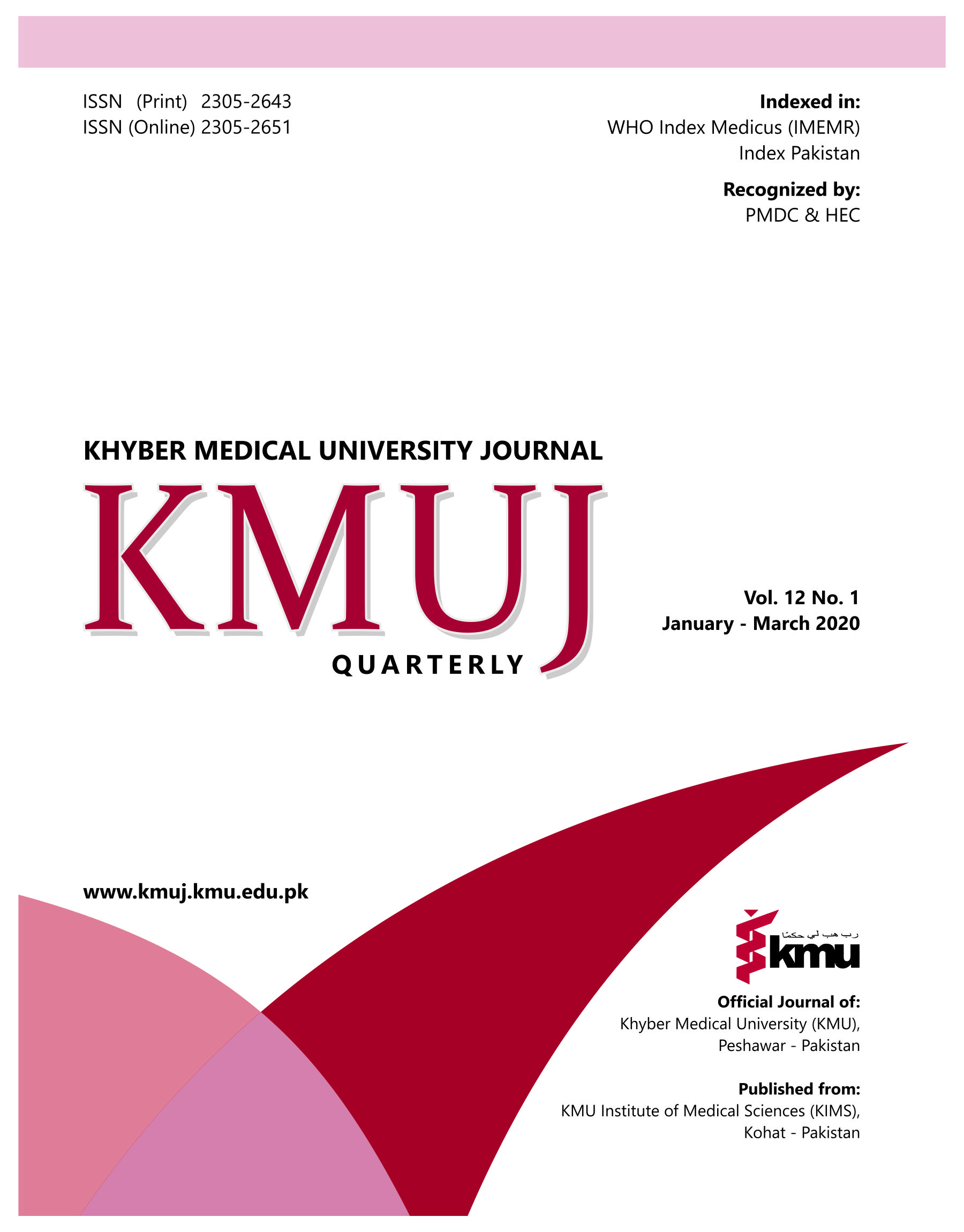PSYCHOLOGICAL MORBIDITY AND SELF-ESTEEM IN PATIENTS OF ACNE VULGARIS: DATA FROM A TERTIARY CARE HOSPITAL IN PAKISTAN
Main Article Content
Abstract
OBJECTIVES: To assess psychological morbidity and level of self-esteem in patients of acne vulgaris.
METHODS: This cross-sectional study was conducted at Shifa International Hospital, Islamabad, Pakistan from June 2017 to December 2017. Study was approved by ethical board of Shifa hospital. One hundred and fifty-six acne vulgaris patients of both genders, aging ≥16 years were selected by convenient sampling technique. Informed consent was taken from all participants. After collecting demographic details, each patient was assessed for psychological morbidity using General Health Questionnaire (GHQ-12) and self-esteem was measured by Rosenberg self-esteem scale (RSES). Data collected was analyzed by using SPSS version 20.
RESULTS: Out of 156 enrolled patients, 108 (69.2%) were females and 48 (30.8%) were males. Mean age of was 22.03±5.96 years. Mean duration of acne was 25.69±21.74 months. The most commonly affected area of the body with acne was face (n=108/156, 69.2%) followed by chest (n=24/156, 15.4%), shoulders (n=13/156, 8.3%) and back (n=11/156, 7.1%). A dominant proportion of the sample had positive family history of acne (82/156, 52.6%), were unmarried (118/156, 75.6%) and had a good educational background [graduates=53/156 (34.0%)]. A total of 27 (17.3%) patients had low esteem reported as per RSES and 146 (93.6%) were labelled as having psychological morbidity as per GHQ-12 scale. Fisher’s exact test showed no statistical significance between low esteem and psychological morbidity (p=0.2126).
CONCLUSION: The patients suffering from acne can suffer from low self-esteem. However, the proportion of patients having psychological morbidity because of acne is much higher and independent of self-esteem.
Article Details
Work published in KMUJ is licensed under a
Creative Commons Attribution 4.0 License
Authors are permitted and encouraged to post their work online (e.g., in institutional repositories or on their website) prior to and during the submission process, as it can lead to productive exchanges, as well as earlier and greater citation of published work.
(e.g., in institutional repositories or on their website) prior to and during the submission process, as it can lead to productive exchanges, as well as earlier and greater citation of published work.
References
Webster GF. The pathophysiology of acne. Cutis 2005;6(2 Suppl):4-7.
Baldwin HE. The interaction between acne vulgaris and the psyche. Cutis 2002;70(2):133-9.
Adebamowo CA, Spiegelman D, Berkey CS, Danby FW, Rockett HH, Colditz GA, et al. Milk consumption and acne in adolescent girls. Dermatol Online J 2006;12(4).
Dalgard F, Gieler U, Holm JØ, Bjertness E, Hauser S. Self-esteem and body satisfaction among late adolescents with acne: results from a population survey. J Am Acad Dermatol 2008;59(5):746-51. DOI: 10.1016/j.jaad.2008.07.013.
Smithard A, Glazebrook C, Williams HC. Acne prevalence, knowledge about acne and psychological morbidity in mid‐adolescence: a community‐based study. Br J Dermatol 2001;145(2):274-9. DOI: 10.1046/j.1365-2133.2001.04346.x.
Sinclair SJ, Blais MA, Gansler DA, Sandberg E, Bistis K, LoCicero A. Psychometric properties of the Rosenberg Self-Esteem Scale: Overall and across demographic groups living within the United States. Eval Health Prof 2010;33(1):56-80. DOI: 10.1177/0163278709356187.
Gnambs T, Staufenbiel T. The structure of the General Health Questionnaire (GHQ-12): two meta-analytic factor analyses. Health Psychol Rev 2018;12(2):179-94. DOI: 10.1080/17437199.2018.1426484.
Pevalin DJ. Multiple applications of the GHQ-12 in a general population sample: an investigation of long-term retest effects. Soc Psychiatry Psychiatr Epidemiol 2000;35(11):508-12. DOI: 10.1007/s001270050272.
Fernandez‐Obregon AC. Azithromycin for the treatment of acne. Int J Dermatol 2000;39(1):45-50. DOI: 10.1046/j.1365-4362.2000.00749.x.
Yazici K, Baz K, Yazici AE, Köktürk A, Tot S, Demirseren D, et al. Disease‐specific quality of life is associated with anxiety and depression in patients with acne. J Eur Acad Dermatol Venereol 2004;18(4):435-9. DOI: 10.1111/j.1468-3083.2004.00946.x.
Mishra N, Rastogi MK, Gahalaut P, Srivastava N, Aggarwal A. Assessment of depression in patients of acne vulgaris and its correlation with severity of acne, post acne scarring and gender. J Pak Assoc Dermatol 2018;27(4):313-9.
Khan MZ, Naeem A, Mufti KA. Prevalence of mental health problems in acne patients. J Ayub Med Coll Abbottabad 2001;13(4):7-8.
Shakoor A, Shaheen JA, Khan JI. Association of anxiety and depression with acne: evaluation of pathoplastic effect of adolescence on this comorbidity. J Pak Assoc Dermatol 2012;22(4):336-41.
Dogar IA, Man MA, Bajwa A, Bhatti A, Naseem S, Kausar S. Dermatological disorders; Psychiatric co-morbidity. Professional Med J 2010;17(02):334-9.
Gallitano SM, Berson DS. How Acne Bumps Cause the Blues: The Influence of Acne Vulgaris on Self-Esteem. Int J Womens Dermatol 2018;4(1):12-7. DOI: 10.1016/j.ijwd.2017.10.004.
Farshi MG, Sharifi HP, Rad MA. The relationship between self-esteem, mental health and quality of life in Patients with skin diseases. Asian J Med Pharm Res 2013;3(2):50-4.
